
Horatio Lloyd Gates was a British-born American army officer who served as a general in the Continental Army during the early years of the Revolutionary War. He took credit for the American victory in the Battles of Saratoga (1777) – a matter of contemporary and historical controversy – and was blamed for the defeat at the Battle of Camden in 1780. Gates has been described as "one of the Revolution's most controversial military figures" because of his role in the Conway Cabal, which attempted to discredit and replace General George Washington; the battle at Saratoga; and his actions during and after his defeat at Camden.
Travelers Rest or Traveller's Rest may refer to:

West Virginia Route 480 is a 5.64-mile-long (9.08 km) state highway in the U.S. state of West Virginia. Known for most of its length as Kearneysville Pike, the highway extends from WV 115 in Kearneysville north to the Maryland state line at the Potomac River in Shepherdstown, from where the highway continues as Maryland Route 34. The route is one of the main north–south highways of northern Jefferson County and passes through the campus of Shepherd University. WV 480 was originally established in the early 1920s as West Virginia Route 48. The highway was paved in the mid-1920s, which included a different routing through Shepherdstown. WV 48's present routing through the town was established in the late 1930s when the first James Rumsey Bridge was completed; that bridge was replaced with the current bridge in the mid-2000s. WV 48 was renumbered to WV 480 in the mid-1970s after U.S. Route 48 was established in West Virginia and Maryland.
Leetown is an unincorporated community in Jefferson County in the U.S. state of West Virginia. It lies along West Virginia Secondary Route 1 at its junction with Leetown Pike.

Architect John Ariss (1725–1799) was born in Westmoreland County, Virginia to a family long settled in the Old Dominion. Several houses now considered National Historic Landmarks have been attributed to him. One of the best documented surviving examples of his work is Traveller's Rest in Kearneysville, West Virginia, which he designed as a farmstead home for American Revolutionary War General Horatio Gates. Ariss is also believed to have designed the Neo-Palladian estate Mount Airy, located in Richmond County, Virginia on Virginia's Northern Neck. In the 1930s, Harewood, a home constructed for Samuel Washington and also now a National Historic Landmark, was also attributed to Ariss, who lived nearby.
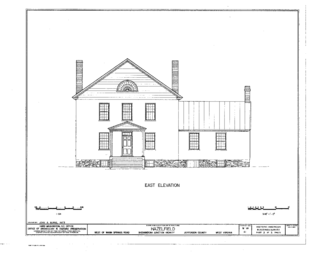
Hazelfield, located near Shenandoah Junction, West Virginia is a historic farm, whose principal residence was built in 1815 for Ann Stephen Dandridge Hunter.

The Peter Burr House was built between 1751 and 1755 near present-day Shenandoah Junction, West Virginia, making it one of the oldest houses in West Virginia. Burr, whose first cousin was Aaron Burr, was one of the first settlers in the area. It is the oldest surviving post-and-beam-construction house in West Virginia. The 9.5-acre (3.8 ha) property was acquired from Burr family descendants in the 1990s and has been under restoration by Jefferson County Historic Landmarks Commission.
The Rellim Farm near Kearneysville, West Virginia is a 50-acre (20 ha) farm and orchard complex which was once part of the nearby Traveller's Rest property. The upper Shenandoah Valley region supports a significant fruit industry, and Rellim Farm is a representative example of this form of agriculture, the oldest family-owned operation in Jefferson County. Beginning in the 1930s, Paul Miller Sr. began to work with the nearby West Virginia University Experimental Farm in the development of spray technology, which was applied throughout the industry.

Harewood is one of several houses in the vicinity of Charles Town, West Virginia built for members of the Washington family.
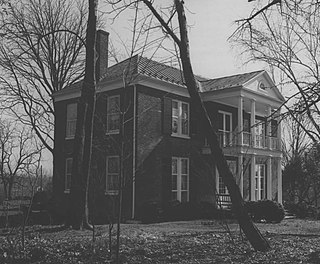
The Morgan-Bedinger-Dandridge House — first known as Poplar Grove, then Rosebrake or Rose Brake — is part of a group of structures affiliated with the Morgan's Grove rural historic district near Shepherdstown, West Virginia. The property was known as "Poplar Grove" until 1877.
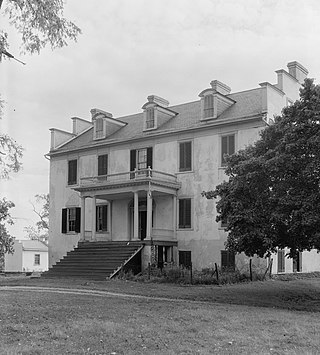
Woodbury or Woodberry, is a historic mansion located near Leetown, Jefferson County, West Virginia. It was built in 1834-1835 for the jurist and Congressman Henry St. George Tucker, Sr. (1780–1848). Tucker lived at Woodbury from its construction until 1844.
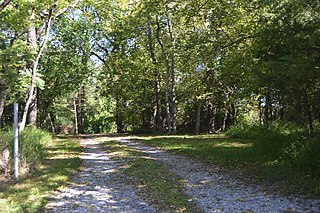
The Strider Farm was intimately involved in events concerning the American Civil War near Harpers Ferry, West Virginia. Located on a small hill just south of the Baltimore and Ohio Railroad line from Baltimore and Washington, D.C. to Martinsburg, West Virginia, the Strider farm was a strategic location for the control of this vital link.
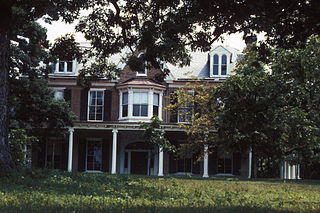
The Bower is an 1806 residence, originally built in the Federal style in Jefferson County, West Virginia, USA. It was later remodeled with Gothic Revival features after a fire in 1892. The name appeared as early as 1753 when Major General Adam Stephen had a hunting lodge at this location.

The Allstadt House and Ordinary was built about 1790 on land owned by the Lee family near Harpers Ferry, West Virginia, including Phillip Ludwell Lee, Richard Bland Lee and Henry Lee III. The house at the crossroads was sold to the Jacob Allstadt family of Berks County, Pennsylvania in 1811. Allstadt operated an ordinary in the house, and a tollgate on the Harpers Ferry-Charles Town Turnpike, while he resided farther down the road in a stone house. The house was enlarged by the Allstadts c. 1830. The house remained in the family until the death of John Thomas Allstadt in 1923, the last survivor of John Brown's Raid.

Sunrise, also known as MacCorkle Mansion, is a historic home located at Charleston, West Virginia. It was built in 1905 by West Virginia's ninth governor, William A. MacCorkle (1857-1930). It is a long, three-story stone mansion. Its gabled roof is dotted with dormers and chimneys and surmounts an intricate, but wide, cornice which gives the illusion that the house is smaller than it actually is. The Georgian structure rests on a bluff overlooking the Kanawha River, and from the northern portico one can see nearly the entire city of Charleston. The north side features four magnificent Doric, or neo-classic, columns which support the cornice and ashlar-finished pediment. In 1961 Sunrise Foundation, Inc., was formed for the purpose of purchasing the mansion and grounds.
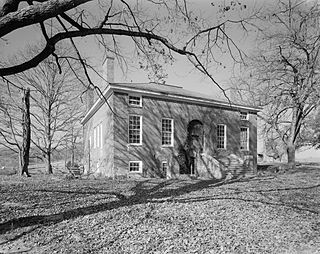
Lynnside Historic District is a national historic district located near Sweet Springs, Monroe County, West Virginia. The district includes six contributing buildings, three contributing sites, and two contributing structures. It consists of three contiguous properties related to the Lewis family home, known as "Lynnside." The main house was built in 1845 on the site of a previous plantation house, and is a 1+1⁄2-story, rectangular masonry dwelling in the Greek Revival style. It measures 70 feet by 40 feet. A fire in 1933, destroyed the roof and porticos. Also on the property are four wooden barns dated to about 1900. Located nearby is the Lewis Family Cemetery, that includes the grave of Virginia Governor John Floyd (1783-1837), and the adjacent Catholic Cemetery dated to 1882. The district also includes St. John's Catholic Chapel (1853-1859), a simple masonry Greek Revival style building, and the adjacent "New Cemetery."
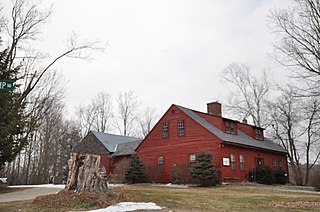
The Moses Eaton Jr. House is a historic house on Hancock Road in Harrisville, New Hampshire. Built about 1790, it is one of the oldest houses in the eastern part of Harrisville, and was home for fifty years to the itinerant folk stenciler Moses Eaton Jr. The house was listed on the National Register of Historic Places in 1988.
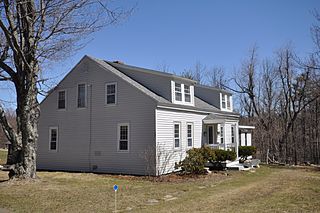
The Benjamin Learned House is a historic house on Upper Jaffrey Road in Dublin, New Hampshire. Built in the late 1760s, it is one of the town's oldest surviving buildings. It is further notable for its association with the locally prominent Learned family, and for its role in the summer estate trend of the early 20th century. The house was listed on the National Register of Historic Places in 1983.

The John Perry Homestead is a historic house at 135 Dooe Road in Dublin, New Hampshire. The 1+1⁄2-story Cape style farmhouse was built c. 1795 by John Perry, son of Ivory Perry who lived nearby. The house has been only minimally altered since its construction, with the replacement of windows and the addition of gable dormers being the most significant. The house was listed on the National Register of Historic Places in 1983.

The Rufus Piper Homestead is a historic house on Pierce Road in Dublin, New Hampshire. The house is a well-preserved typical New England multi-section farmhouse, joining a main house block to a barn. The oldest portion of the house is one of the 1+1⁄2-story ells, a Cape style house which was built c. 1817 by Rufus Piper, who was active in town affairs for many years. The house was listed on the National Register of Historic Places in 1983. The home of Rufus Piper's father, the Solomon Piper Farm, also still stands and is also listed on the National Register of Historic Places.






















